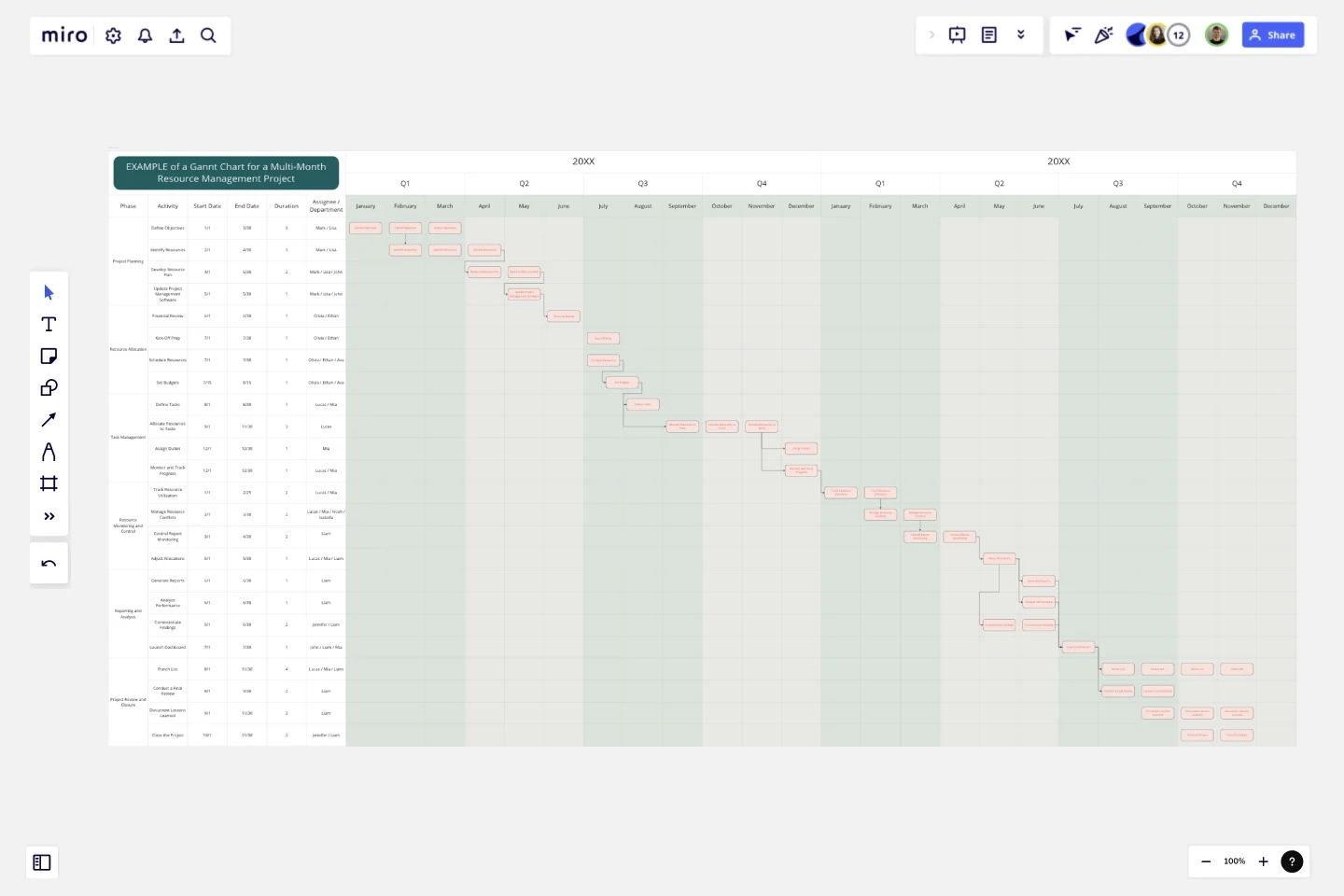Resource Management Gantt Chart
The Resource Management Gantt Chart template is designed to help teams efficiently plan, allocate, and manage resources throughout a project.
It provides a visual timeline for tasks and resource usage, ensuring that resources are optimally utilized and potential conflicts are identified early.
Key Features
Project Phases: Includes clearly defined phases relevant to resource management, such as Planning, Resource Allocation, Task Management, Monitoring and Control, Reporting, and Project Closure.
Task Breakdown: Allows for a detailed listing of tasks or milestones within each phase. This ensures that all necessary activities are planned and tracked.
Timeline Visualization: Offers a visual representation of the project timeline, including start and end dates for each task. This helps in scheduling and understanding resource demands over time.
Resource Allocation: Provides columns to assign and track resources (such as team members, equipment, and materials) for each task, ensuring clear visibility of who or what is involved.
Dependency Tracking: Shows dependencies between tasks, indicating which tasks need to be completed before others can start. This helps in coordinating resources and scheduling effectively.
Progress Tracking: Includes sections for updating the status of each task and resource utilization, making it easier to monitor progress and make necessary adjustments.
Resource Utilization: Helps in managing and optimizing resource use by providing an overview of how and when resources are being allocated.
Conflict Identification: Assists in identifying and resolving resource conflicts or over-allocations by providing a clear view of resource assignments and schedules.
Why Use the Resource Management Gantt Chart Template?
Organized Resource Planning: Helps structure and organize resource planning, ensuring that all resources are accounted for and allocated appropriately throughout the project.
Visual Clarity: Provides a clear, visual timeline of the project and resource usage, making it easy to understand scheduling and resource demands.
Efficient Allocation: Facilitates effective allocation of resources by showing which resources are needed for which tasks and when, helping to prevent overallocation or shortages.
Improved Coordination: By showing task dependencies and resource assignments, it aids in coordinating efforts among team members and avoiding scheduling conflicts.
Enhanced Tracking: Allows for regular updates and tracking of both task progress and resource utilization, ensuring that the project stays on track and resource issues are addressed promptly.
Informed Decision-Making: Supports better decision-making by providing a structured and comprehensive view of resource management, helping to make adjustments as needed.
When to Use This Template:
For Complex Projects: When managing multiple resources and tasks, this template helps to ensure that resources are allocated efficiently and project timelines are adhered to.
When Coordinating Teams: To clearly assign and track responsibilities and resources, especially in projects involving multiple team members or departments.
For Resource Optimization: To manage and optimize resource use, avoiding conflicts and ensuring that resources are used effectively throughout the project.
The Resource Management Gantt Chart template is a valuable tool for managing project resources, providing clarity, structure, and efficiency in resource planning and utilization.
This template was created by Anthony.
Get started with this template right now.
Action Priority Matrix Template
Works best for:
Mapping
You and your teammates probably have more ideas than resources, which can make it difficult to prioritize tasks. Use an Action Priority Matrix to help choose the order in which you will work on your tasks, allowing you to save time and money and avoid getting bogged down in unnecessary work. An Action Priority Matrix is a simple diagram that allows you to score tasks based on their impact and the effort needed to complete them. You use your scores to plot each task in one of four quadrants: quick wins, major projects, fill-ins, and thankless tasks.
Work Breakdown Structure Template
Works best for:
Project Management, Mapping, Workflows
A work breakdown is a project management tool that lays out everything you must accomplish to complete a project. It organizes these tasks into multiple levels and displays each element graphically. Creating a work breakdown is a deliverable-based approach, meaning you’ll end up with a detailed project plan of the deliverables you must create to finish the job. Create a Work Breakdown Structure when you need to deconstruct your team's work into smaller, well-defined elements to make it more manageable.
Venn Diagram Practical Applications
Works best for:
Venn Diagram
The Venn Diagram for Practical Applications template helps you apply Venn diagrams to real-world scenarios. Use this template to solve problems, identify relationships, and make decisions based on clear visual analysis. It's perfect for practical tasks such as project planning, resource allocation, and strategic decision-making. This tool is ideal for business professionals, educators, and anyone looking to apply theoretical concepts to practical situations.
Fishbone Diagram for Service Improvement
Works best for:
Fishbone diagram
The Basic Fishbone Diagram, also known as the Ishikawa or cause-and-effect diagram, is a powerful tool for identifying the root causes of problems. Use this template to systematically explore and document potential causes of an issue, categorizing them into key areas such as people, processes, equipment, and materials. This visual approach helps teams collaborate on problem-solving, ensuring all factors are considered and addressed effectively.
The Lightning Product Audit
Works best for:
Product Management, Planning
The Lightning Product Audit template streamlines product evaluation processes with a comprehensive framework. By assessing key areas such as market fit, user experience, and feature performance, this template enables teams to identify strengths, weaknesses, and areas for improvement swiftly. With sections for conducting SWOT analysis, user feedback review, and competitive benchmarking, it facilitates data-driven decision-making and prioritization. This template serves as a catalyst for refining product strategies and driving continuous improvement.
Fishbone Diagram for Marketing
Works best for:
Fishbone Diagram
Optimizing marketing strategies requires identifying underlying issues. The Fishbone Diagram Marketing template helps you systematically explore factors affecting your campaigns. Categorize potential causes into areas such as market research, product positioning, promotional strategies, and distribution channels. This structured analysis enables your team to pinpoint and address issues, enhancing marketing effectiveness and achieving better results.
